
A vehicle electrical system is responsible for starting your engine and recharging the battery, as well as powering components like lights and entertainment systems. It’s also responsible for a growing number of newer safety features like seatbelt warning lights and even electronic steering. So whether your car isn’t turning on or your headlights aren’t working, an issue with the electrical system can be a major headache and potentially expensive to repair.
In the past, a problem with the electrical system could mean a dead battery or faulty alternator. Today, many problems with the electrical system are more likely to be caused by faulty computer sensors or wiring issues. If you have any of these issues, it’s important to see a certified auto electrical technician right away to prevent the problem from getting worse and possibly damaging other components.
The basics of the auto electrical system consist of a battery, an alternator and a voltage regulator. When you turn on the ignition, your battery supplies current to the starter motor and then charges the alternator. The alternator then powers the vehicle’s other electrical systems and returns current to the battery. When everything is working correctly, current flows in a closed circuit.
This diagram illustrates how the basic auto electrical system works. Notice that the components are drawn in straight lines, but they’re actually anything but. The actual wires are often very twisted and knotted and bound together in a thick plastic or cloth sheath called the wiring loom. Whenever possible, the twisted and knotted wires are colour coded to make them easier to trace in the engine bay or workshop. Most service manuals have a wiring diagram which can be helpful in tracing the circuits.
A common automotive electrical problem is an open circuit. This fault occurs when high resistance chokes the flow of current through a wire, which causes it to overheat and burn. It can also occur when corrosion inside an electrical connector stops it from sealing properly and creating a path for current to escape.
In this case, the ohmmeter will read a very low value. This is because a short circuit will not cause a sudden increase in resistance, but rather a steady, gradual increase over time. To diagnose this kind of problem, it is necessary to understand Ohms Law and how volts, amps and ohms relate to each other.
Never disconnect any electrical connector while the engine is running or the key is in the “on” position (unless instructed to do so as part of a diagnostic procedure in a shop manual). This can create a shock and damage sensitive electrical components.
Be extra careful after a storm or when dealing with downed power lines or other damaged electric equipment. It’s best to stay inside your vehicle until utility professionals say it is safe to leave. If you must go outside, do not touch the ground or the vehicle and jump or shuffle your feet to avoid becoming a pathway for electricity.



0 Comments